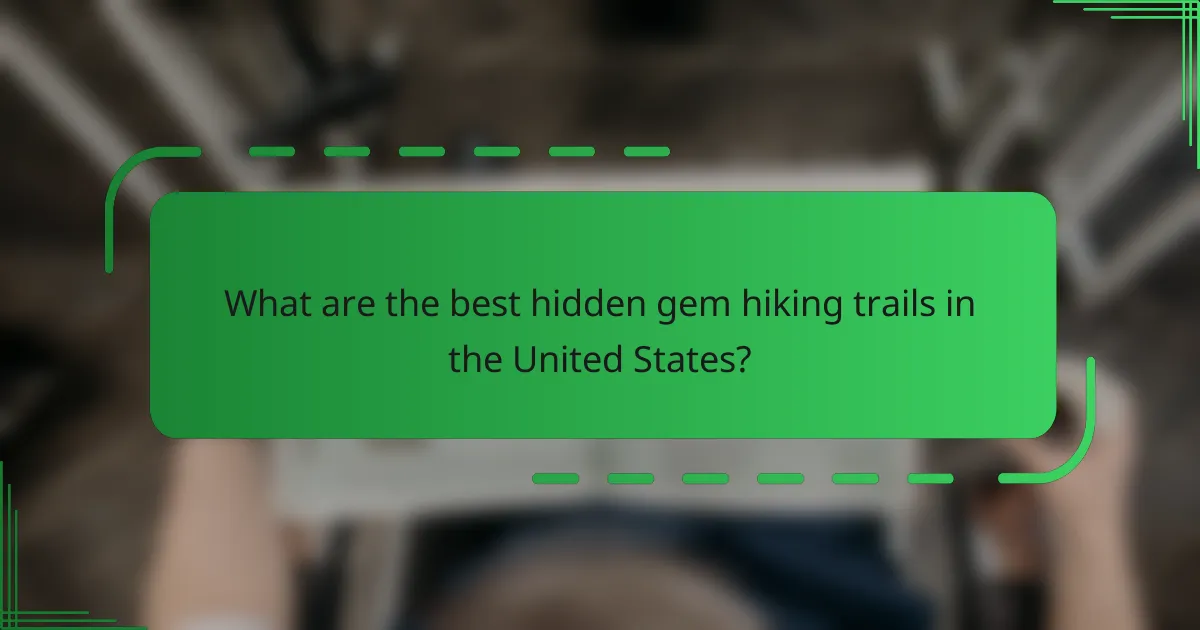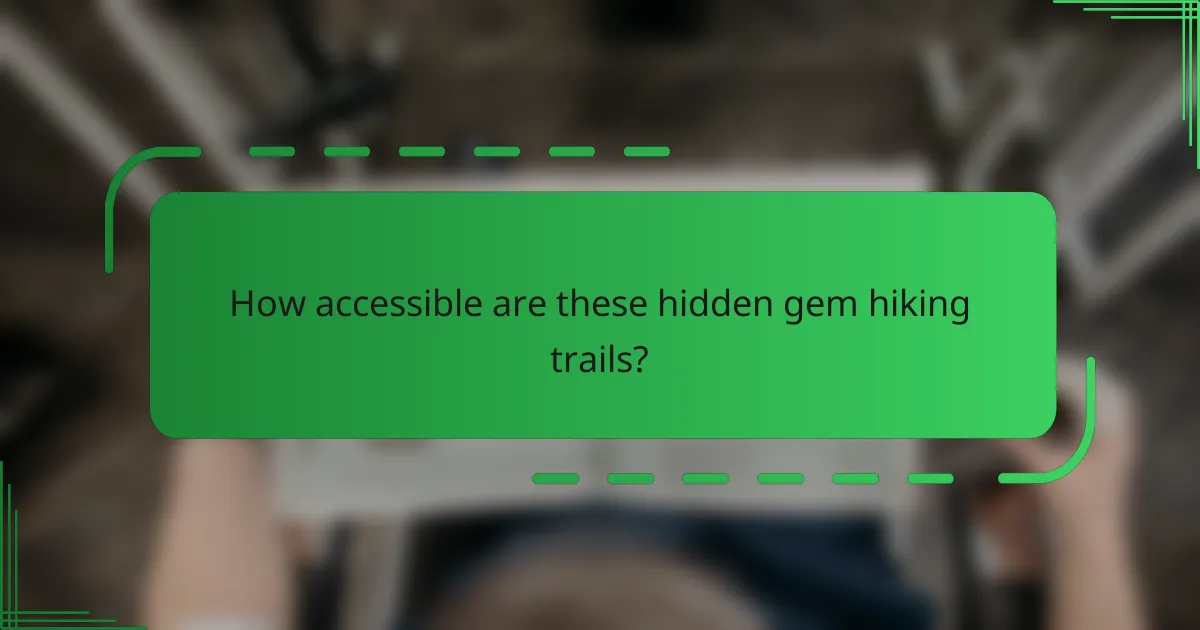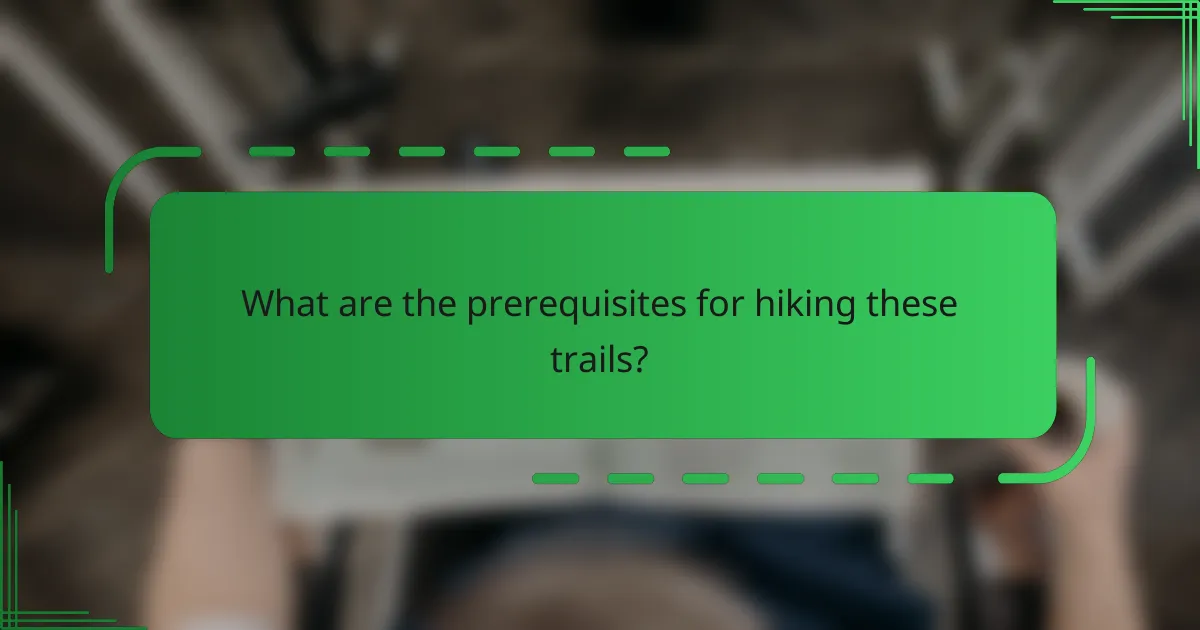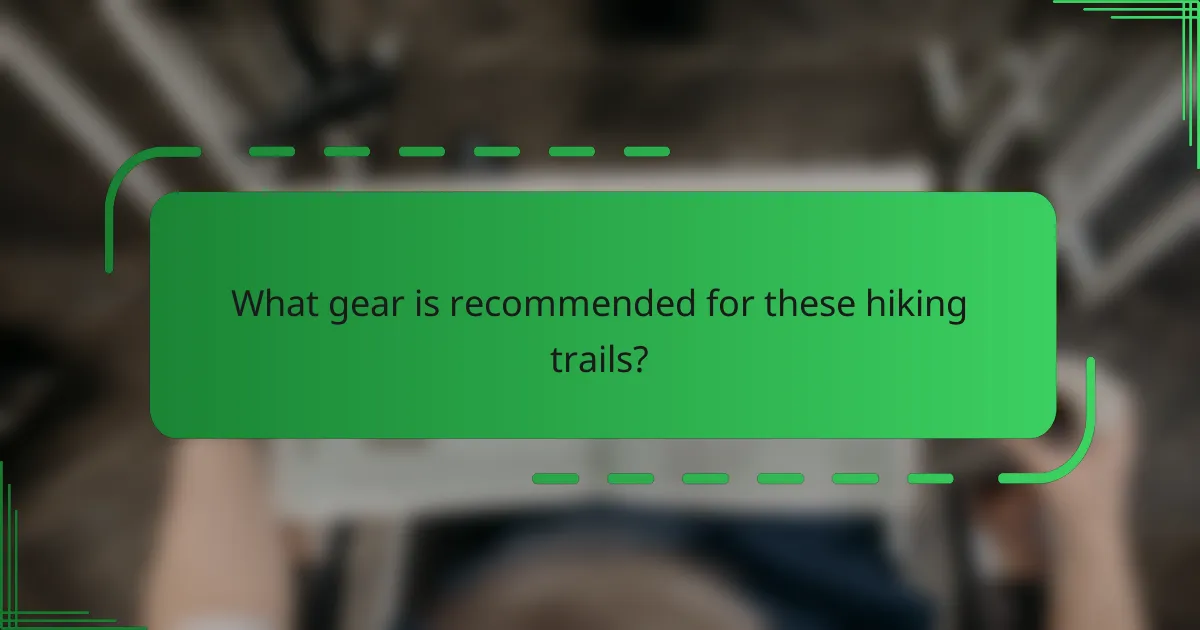Discover the beauty of hidden gem hiking trails across the United States, where unique landscapes and serene environments await adventurous hikers. These secluded spots offer breathtaking views, diverse ecosystems, and distinctive features, making them perfect for those seeking a peaceful escape from the crowds. While accessibility may vary, the rewarding experiences found on these trails are well worth the journey.

What are the best hidden gem hiking trails in the United States?
The best hidden gem hiking trails in the United States offer unique landscapes and experiences away from the crowds. These trails often feature stunning views, diverse ecosystems, and varying levels of accessibility, making them ideal for adventurous hikers seeking solitude.
Angels Landing, Zion National Park
Angels Landing is a breathtaking trail in Zion National Park, known for its steep drop-offs and panoramic views. The hike is about 5 miles round trip with a challenging final ascent that requires navigating narrow ridges. Hikers should be cautious, as the trail can be dangerous, especially in wet conditions.
Permits are required for the final section of the hike, which can be obtained through a lottery system. It’s advisable to start early in the day to avoid crowds and enjoy the serene beauty of the park.
Mount Rainier’s Wonderland Trail
The Wonderland Trail encircles Mount Rainier and spans approximately 93 miles, showcasing diverse ecosystems and stunning vistas. This trail is best suited for experienced hikers, as it includes significant elevation changes and can take around 10-14 days to complete. Backpacking permits are required for overnight stays.
Hikers should prepare for varying weather conditions and carry sufficient supplies, as sections of the trail may be remote. The ideal time to hike is during the summer months when the snow has melted and wildflowers bloom.
Old Rag Mountain, Virginia
Old Rag Mountain offers a challenging hike in Shenandoah National Park, with a loop of about 9 miles featuring rock scrambles and stunning views from the summit. The trail is popular but less crowded than some other Virginia hikes, providing a sense of seclusion.
Parking is limited, so arriving early is essential. Hikers should be prepared for steep sections and potentially slippery rocks, especially after rain. The best time to visit is during the fall for vibrant foliage.
Havasu Falls, Arizona
Havasu Falls is a stunning oasis located in the Grand Canyon, famous for its turquoise waters and picturesque waterfalls. Accessing this hidden gem requires a permit, which can be challenging to obtain due to high demand. The hike to the falls is about 10 miles one way, with options for camping nearby.
Hikers should plan ahead, as the area can get very hot in the summer months. It’s crucial to carry enough water and food, and to respect the natural environment by following Leave No Trace principles.
Precipice Trail, Acadia National Park
The Precipice Trail in Acadia National Park is a thrilling hike featuring iron rungs and ladders that lead to breathtaking views of the coastline. This 2-mile trail is steep and can be strenuous, making it suitable for experienced hikers only. The trail is typically open from late spring to early fall, depending on weather conditions.
Hikers should be cautious of heights and ensure they have proper footwear. It’s advisable to start early in the day to avoid crowds and to enjoy the cooler morning temperatures. Always check for park alerts before your visit to ensure the trail is open.

What unique features do these trails offer?
Hidden gem hiking trails often showcase unique features that set them apart from more popular routes. These can include breathtaking vistas, rare wildlife, stunning waterfalls, and historical landmarks, all contributing to a memorable outdoor experience.
Stunning vistas and rock formations
Many secluded hiking trails offer breathtaking views and impressive rock formations that are often overlooked. Trails like the Grand Canyon’s lesser-known paths or the rugged cliffs of the Pacific Northwest provide panoramic vistas that reward hikers with stunning photo opportunities.
When exploring these trails, consider the time of day for optimal lighting. Early morning or late afternoon often yields the best views, with softer light enhancing the natural beauty of the landscape.
Rare wildlife sightings
Hidden trails frequently provide opportunities to observe wildlife that may not be seen in more trafficked areas. Species such as deer, foxes, and various bird species thrive in these quieter environments, making for an exciting experience for nature enthusiasts.
To increase your chances of spotting wildlife, hike during early morning or dusk when animals are most active. Staying quiet and moving slowly can also help you encounter these creatures without startling them.
Waterfalls and natural pools
Secluded hiking trails often lead to beautiful waterfalls and natural pools, perfect for cooling off after a long trek. Trails in regions like the Appalachian Mountains or the Sierra Nevada frequently feature these refreshing spots, providing a serene atmosphere for relaxation.
When visiting these areas, ensure you follow local regulations regarding swimming or wading, as some natural pools may have specific guidelines to protect the ecosystem.
Historical landmarks
Some hidden trails are rich in history, leading hikers to significant landmarks that tell the story of the region. From old mining sites in the Rockies to ancient Native American rock art in the Southwest, these trails offer a glimpse into the past.
Before embarking on your hike, research the historical significance of the area to enhance your experience. Understanding the context can deepen your appreciation for the landmarks you encounter along the way.

How accessible are these hidden gem hiking trails?
Hidden gem hiking trails vary in accessibility, often depending on their location and the amenities available. Many of these trails are designed to be less crowded, but this can sometimes mean limited access to facilities and transportation options.
Trailhead parking availability
Trailhead parking can be a crucial factor when planning a hike on hidden gem trails. Some locations offer ample parking, while others may have only a few spots or none at all. It’s advisable to check online resources or local guides for specific trailhead information to avoid surprises.
Consider arriving early, especially on weekends, as popular trails may fill up quickly. If parking is limited, look for nearby alternative lots or consider carpooling with fellow hikers.
Public transportation options
Public transportation to hidden gem hiking trails can be limited, especially in rural areas. Some trails may be accessible via local bus routes or shuttle services, but these options vary widely by region. Researching transportation options ahead of time can help ensure a smooth journey.
For those without a vehicle, consider reaching out to local hiking groups or forums for advice on shared rides or public transit tips. In some cases, rideshare services may also be available to drop you off at the trailhead.
Difficulty levels and trail conditions
The difficulty levels of hidden gem hiking trails can range from easy walks to challenging treks. It’s essential to assess your fitness level and experience when choosing a trail, as some may have steep inclines or rugged terrain. Look for trail descriptions that include difficulty ratings to guide your selection.
Trail conditions can also vary significantly based on weather and maintenance. Before heading out, check recent trail reports or local hiking websites for updates on conditions, such as muddy paths or downed trees. Always be prepared for changing weather and carry appropriate gear.

What are the prerequisites for hiking these trails?
To hike hidden gem trails, you need to consider your physical fitness, any necessary permits, and local regulations. Being prepared ensures a safe and enjoyable experience while exploring these secluded spots.
Physical fitness requirements
Physical fitness is crucial when tackling hidden gem hiking trails, as many are less maintained and can be more challenging than popular routes. Depending on the trail’s difficulty, you may encounter steep inclines, rocky terrain, or long distances.
For moderate trails, a general fitness level that allows for several hours of walking or hiking is often sufficient. More strenuous hikes may require advanced endurance and strength, so it’s wise to assess your capabilities before embarking on a journey.
Permits and regulations
Many hidden gem trails are located in protected areas, which may require permits for access. Researching the specific trail beforehand is essential to determine if you need a permit and how to obtain it.
In addition to permits, be aware of local regulations such as campfire restrictions, wildlife protection rules, and trail usage guidelines. Following these rules not only preserves the natural environment but also enhances your safety while hiking.

What gear is recommended for these hiking trails?
For hidden gem hiking trails, essential gear includes durable footwear, appropriate clothing, and reliable navigation tools. Selecting the right equipment enhances safety and comfort while exploring these secluded spots.
Footwear and clothing essentials
Choosing the right footwear is crucial for hiking on varied terrain. Opt for sturdy hiking boots or shoes with good traction and ankle support, especially if trails are rocky or uneven. Waterproof options can be beneficial in wet conditions.
Clothing should be layered to adapt to changing weather. Start with moisture-wicking base layers, add insulating mid-layers, and finish with a waterproof outer layer. Don’t forget a wide-brimmed hat and sunglasses for sun protection, especially in exposed areas.
Navigation tools and apps
Reliable navigation tools are vital for exploring hidden hiking trails. A physical map and compass are essential backups, but GPS devices and smartphone apps can provide real-time tracking and trail information. Popular apps like AllTrails or Gaia GPS can help you find routes and read user reviews.
Before heading out, download maps for offline use in case of poor signal areas. Always check for trail updates and conditions, as some paths may be less maintained or have seasonal closures. Familiarize yourself with the app’s features to ensure you can navigate effectively.



